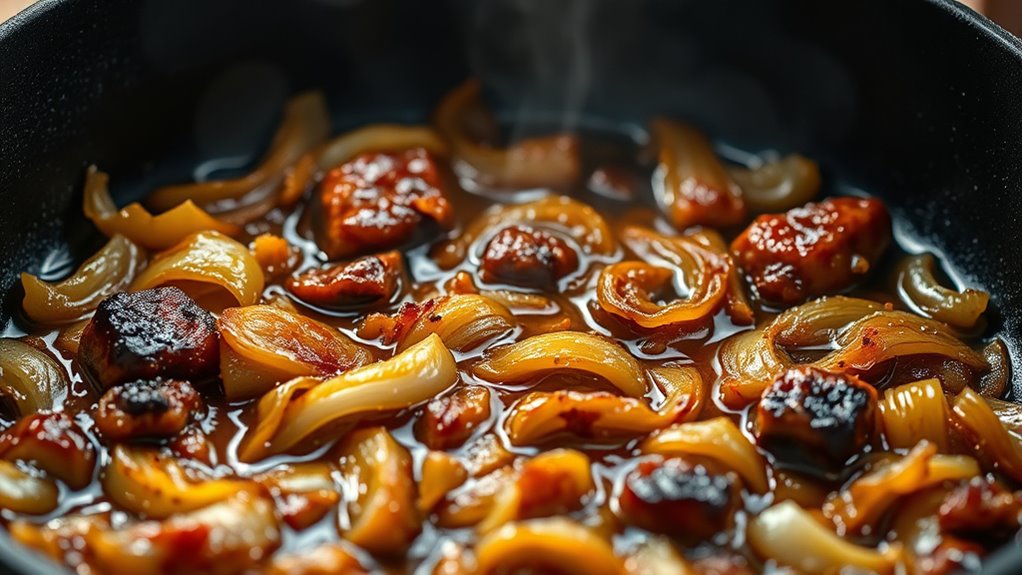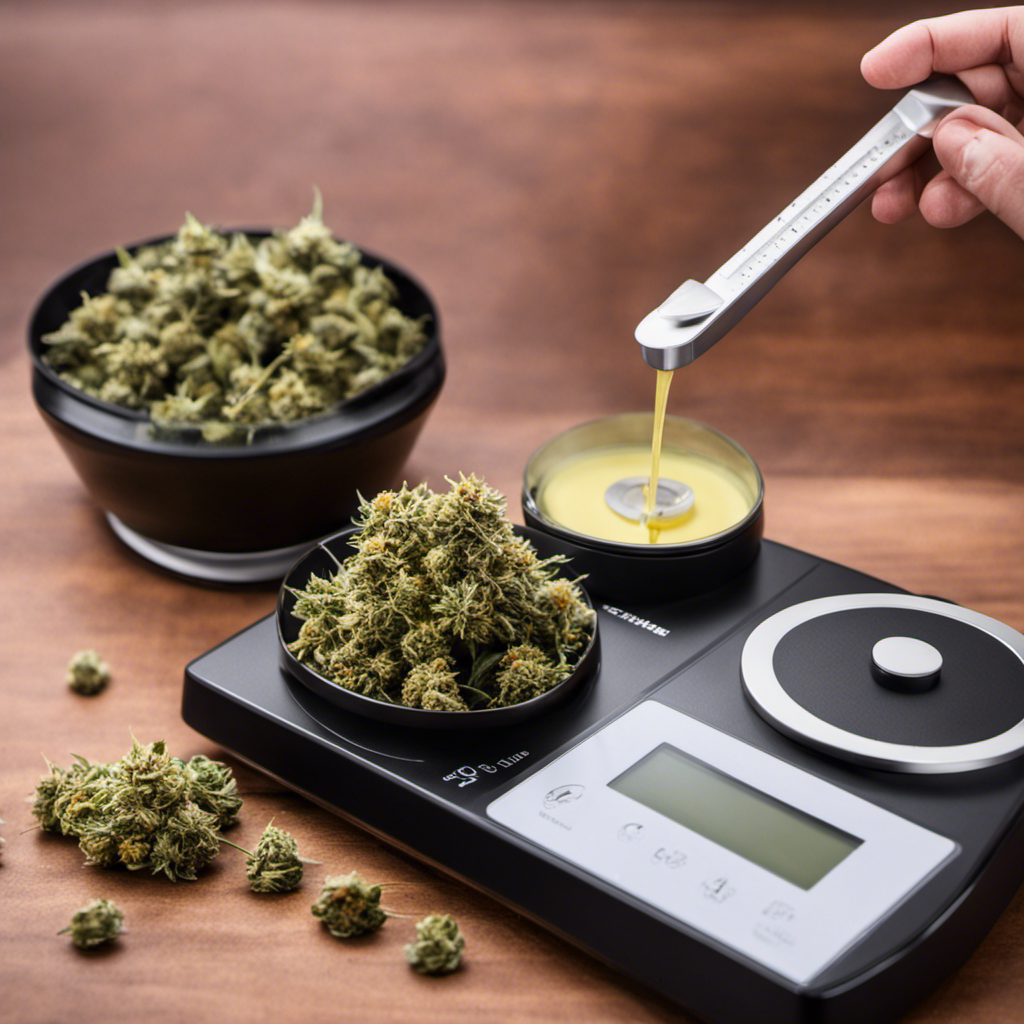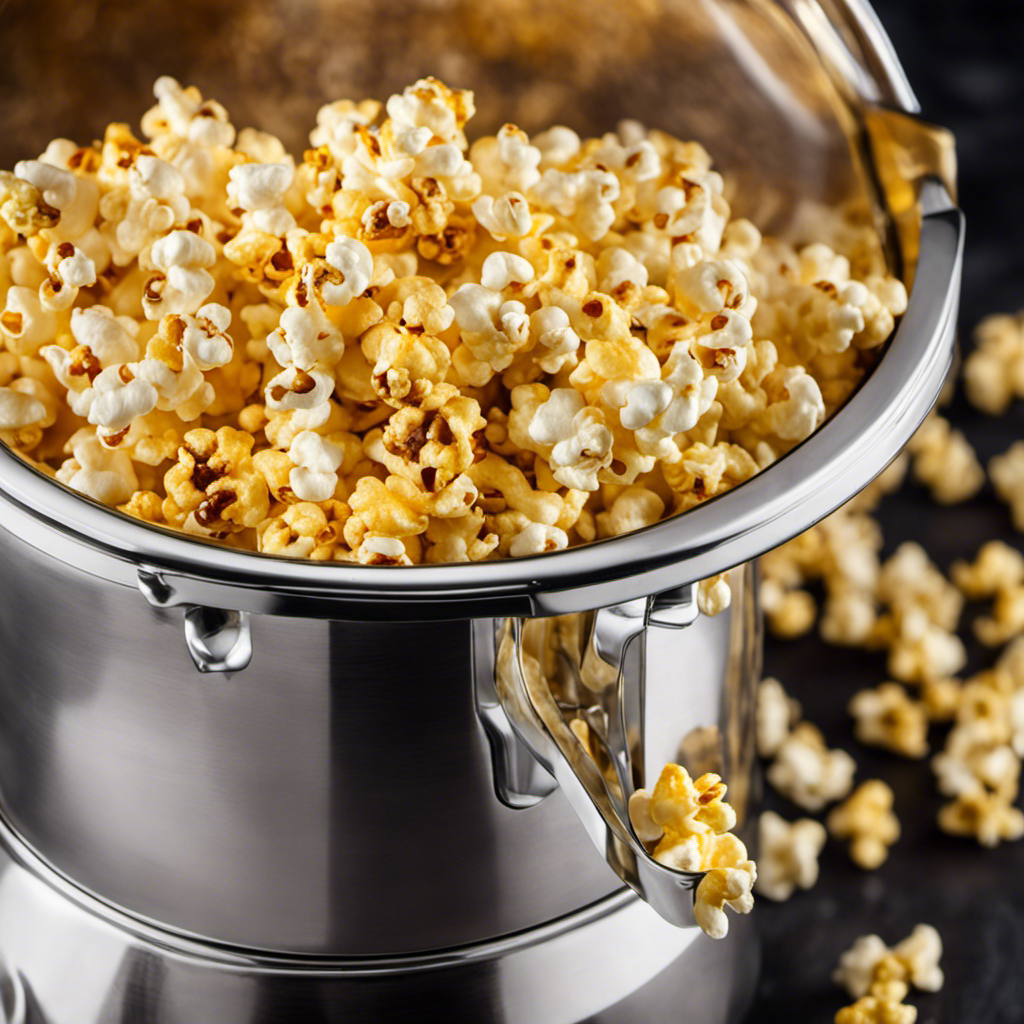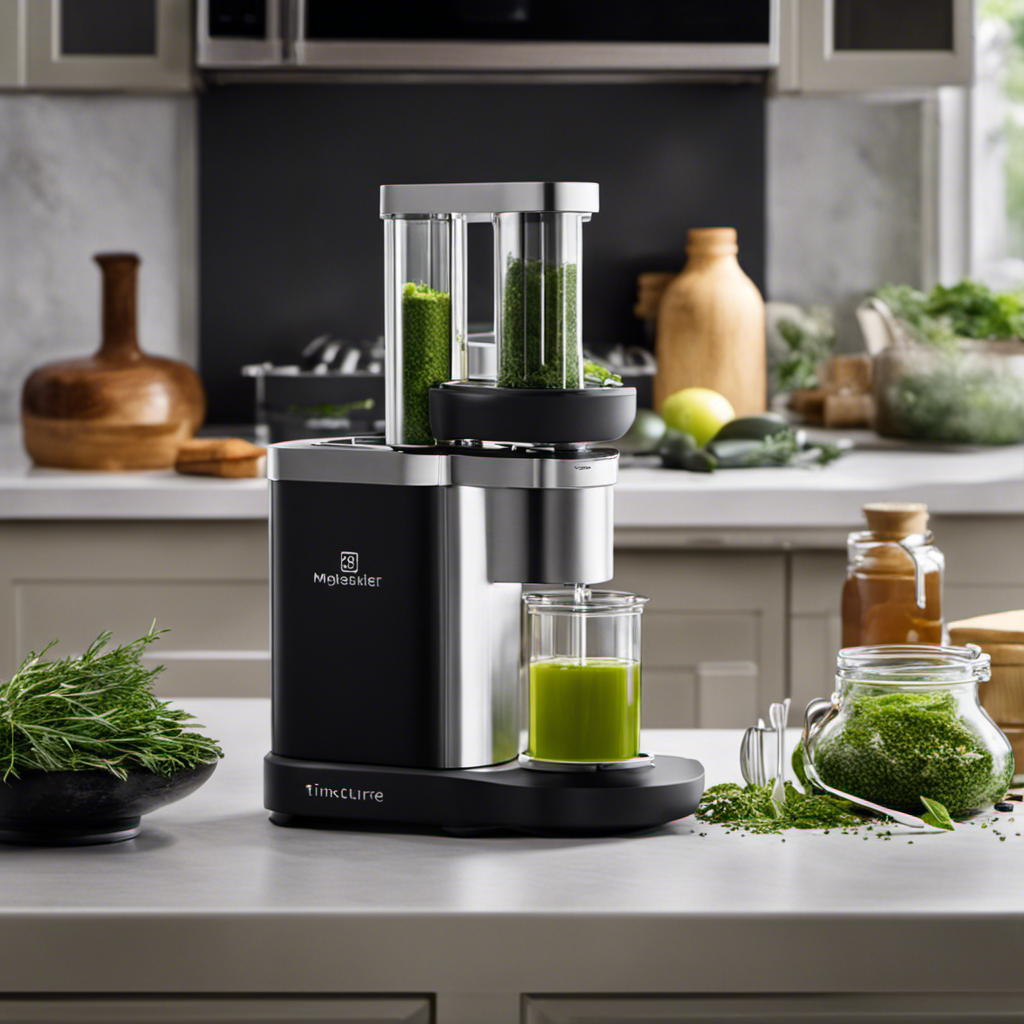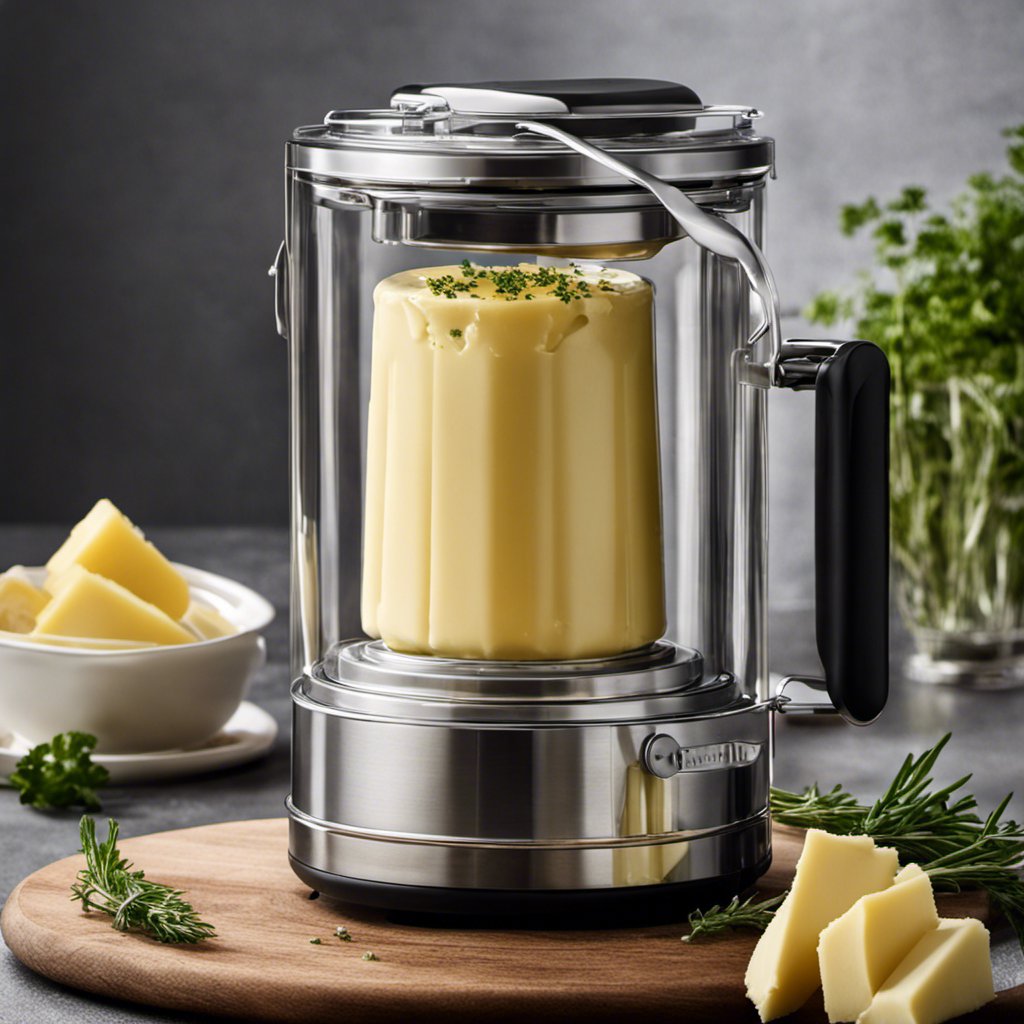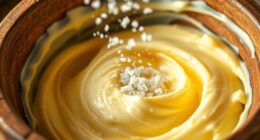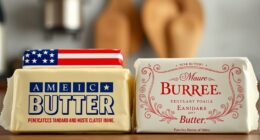To improve your Maillard reaction, start by thoroughly drying ingredients before cooking to prevent excess moisture that stalls browning. Keep your heat between 300-350°F, avoid overcrowding the pan, and always preheat your oven or pan first. Use oils with high smoke points and adjust for humidity or altitude as needed. Remember, controlling pH with ingredients like lemon juice can boost browning. Master these tips to unleash rich flavors—more secrets await if you explore further.
Key Takeaways
- Ensure ingredients are thoroughly dried to prevent excess moisture that hampers browning and flavor development.
- Maintain proper cooking temperature (300-350°F) and use a thermometer to promote optimal Maillard reaction.
- Avoid overcrowding pan or oven, which traps moisture and causes steaming instead of browning.
- Preheat your pan or oven fully before adding ingredients to achieve even heat distribution.
- Select appropriate fats with high smoke points and control environmental factors like humidity to support browning.
Not Drying Ingredients Properly Before Cooking
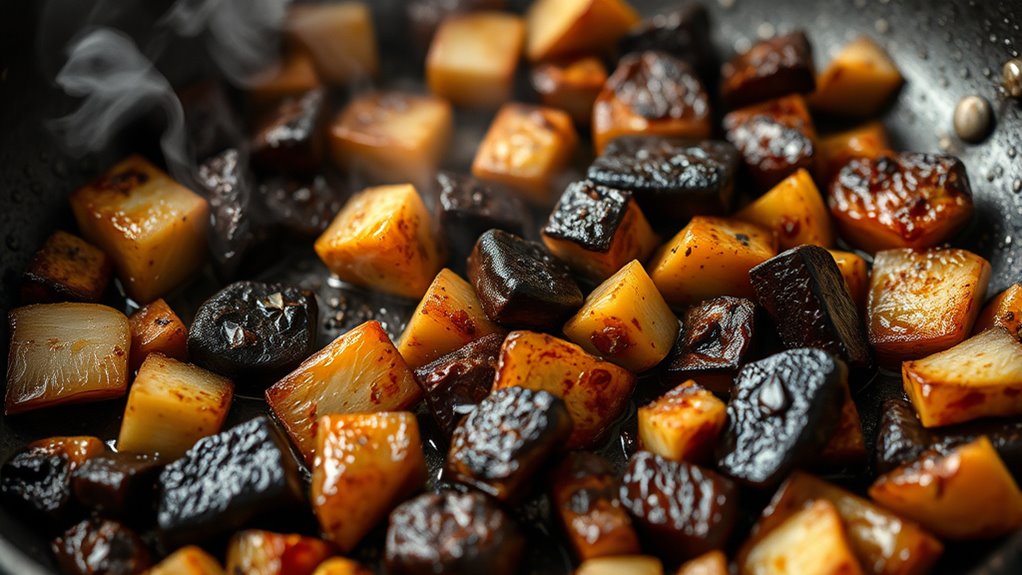
If your ingredients are too wet, it can prevent the Maillard reaction from happening properly. Moisture interferes with the browning process, making it harder for the sugars and amino acids to react. To guarantee ideal browning, focus on ingredient dryness by thoroughly drying surfaces before cooking. Proper moisture control helps create the dry, hot environment needed for the Maillard reaction to develop rich flavors and appealing color. For meats, pat them dry with paper towels to remove excess moisture. Vegetables should be rinsed and then dried completely with a towel or spin in a salad spinner. Skipping this step can lead to steaming rather than browning, hampering flavor development. Mastering moisture control is essential for achieving that delicious, browned exterior everyone desires.
Cooking at Too Low a Temperature

Cooking at too low a temperature can markedly hinder the Maillard reaction, preventing your food from developing its desired browned crust and rich flavors. Proper temperature control is essential to achieve the right level of browning. When heat is too low, the chemical reactions occur slowly or not at all, resulting in pale, flavorless food. Pay attention to heat distribution; uneven heat can cause parts of your dish to cook too slowly while others brown too quickly. Using a reliable thermometer helps you maintain an ideal temperature, usually between 300-350°F (150-175°C) for browning. Avoid cranking up the heat excessively, but don’t underheat either. Consistent, appropriate heat allows the Maillard reaction to proceed efficiently, giving you that perfect, flavorful crust. Understanding industry trends aids in selecting the best cooking methods for optimal browning.
Using Excess Moisture During Browning
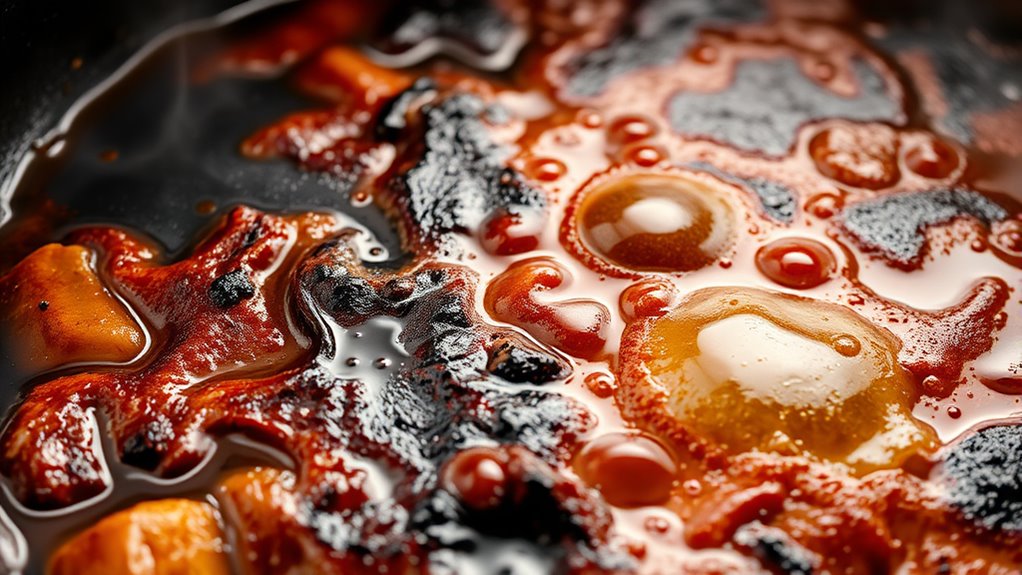
Excess moisture can considerably hinder the Maillard reaction because water absorbs heat and cools the surface of your food, preventing it from reaching the temperature needed for browning. When there’s too much moisture, browning barriers form, making it difficult for the Maillard reaction to occur effectively. For example, wet meat or vegetables release steam during cooking, which slows down the browning process and results in dull, less flavorful dishes. To fix this, pat your ingredients dry before cooking, and avoid overcrowding the pan, which traps moisture. Searing or pre-cooking to evaporate excess water helps achieve a dry surface. Additionally, using proper cooking techniques can enhance browning and flavor development. By reducing excess moisture, you allow the temperature to rise, promoting better browning and richer flavor development.
Skipping the Preheat Step
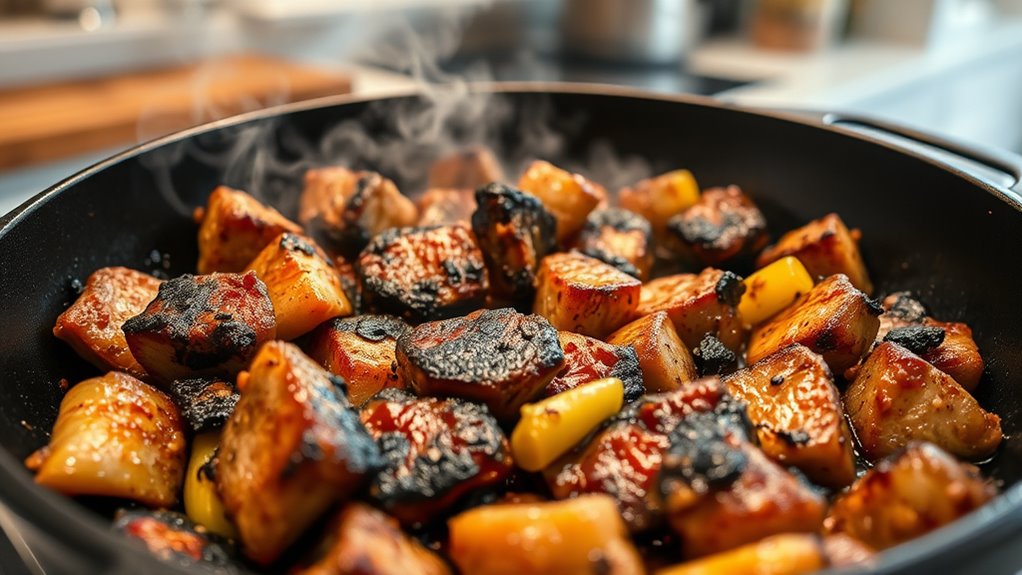
If you skip preheating your oven, your food won’t brown evenly or develop that rich Maillard reaction you’re aiming for. Properly preheating guarantees consistent heat distribution from the start, which is essential for even caramelization. Take the time to preheat thoroughly—you’ll see better results and avoid common mistakes. Additionally, understanding the signs of spoilage in ingredients like lemon juice can help ensure you’re working with fresh components for optimal browning.
Preheat Oven Properly
Skipping the preheat step can sabotage your Maillard reaction, resulting in uneven browning and less flavor development. When you neglect to properly preheat your oven, the oven temperature isn’t stable, which affects how your food reacts during cooking. The preheating process ensures the oven reaches and maintains the right temperature for maximum browning. If you add your food before the oven is fully heated, you risk cooking at a lower temperature initially, preventing proper Maillard reactions. Always give your oven enough time to reach the desired temperature specified in your recipe. This small step helps create an even heat environment, leading to consistent browning, richer flavors, and better overall results. Proper preheating is essential for achieving that perfect, flavorful crust. Additionally, understanding the role of temperature control in the Maillard reaction can help you optimize your cooking process for better taste and appearance.
Ensure Even Heating
Ensuring even heating is essential for consistent Maillard reactions, and neglecting to preheat your oven properly can lead to uneven temperature distribution. Without proper temperature control, some areas may be too hot while others remain too cool, preventing uniform browning. To fix this, always preheat your oven fully before cooking. Use an oven thermometer to verify the actual temperature matches the setting, as built-in thermostats can be inaccurate. Arrange your food so it’s exposed to even heat, avoiding overcrowding that blocks airflow. This helps maintain even heat distribution throughout the cooking process. When your heat is consistent, you’ll achieve better Maillard reactions, resulting in perfectly browned, flavorful food. Proper preheating and mindful placement are key to mastering even heating for ideal results.
Overcrowding the Pan

When you overcrowd the pan, your food steams instead of browns, preventing that perfect Maillard reaction. Make sure to use proper spacing so heat distributes evenly, and cook in batches if needed. This way, each piece gets enough contact with the pan for a beautiful, flavorful crust. Proper spray technique also ensures better browning and minimizes issues like uneven coating or overspray.
Use Proper Spacing
Overcrowding the pan can considerably hinder the Maillard reaction, as it prevents the heat from evenly circulating around the food. When you pack too many ingredients together, they steam rather than brown, sacrificing flavor and texture. To optimize browning, give each piece enough space so heat can reach all sides evenly. Proper spacing also helps you refine your spice combinations, as spices need direct contact with hot surfaces to develop rich flavors. Additionally, using fresh ingredients ensures they release moisture properly, making browning more consistent. If you crowd the pan, moisture buildup can stall the Maillard process, resulting in uneven color and less complex flavors. Keep ingredients separated enough to promote even browning, enhancing both appearance and taste. Maintaining proper heat transfer is essential for achieving optimal Maillard reactions and flavor development.
Cook in Batches
Why does cooking in large quantities at once hinder the Maillard reaction? When you try batch cooking by overcrowding the pan, the ingredients don’t dry out properly, which is essential for browning. Excess moisture from overcrowding lowers the temperature, preventing the Maillard reaction from occurring efficiently. Instead of achieving that desirable caramelized crust, the ingredients steam, leading to sogginess and uneven browning. To fix this, cook in smaller batches, allowing each piece enough space to dry slightly and brown evenly. Proper ingredient drying ensures better heat transfer and allows the Maillard reaction to develop fully. Additionally, controlling moisture levels is crucial for optimal browning. Remember, giving each batch room helps you get that perfect, flavorful crust without sacrificing texture or color.
Not Giving Food Enough Time to Brown
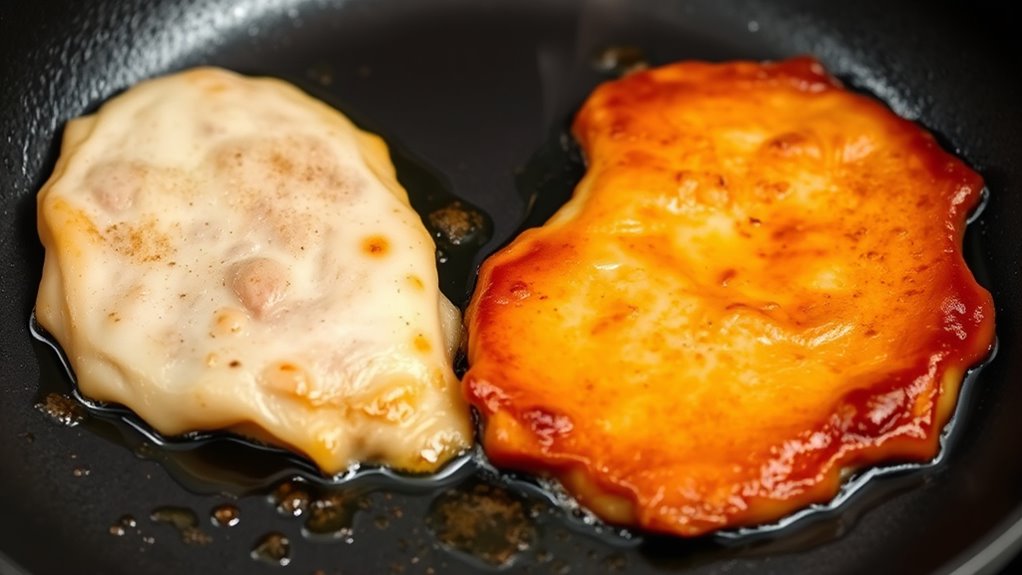
Rushing the cooking process often prevents food from developing the rich, complex flavors characteristic of the Maillard reaction. To guarantee proper browning, you need to allow enough time for the surface to form those desirable flavors. First, focus on drying techniques: moist surfaces hinder browning, so pat food dry before cooking. Second, monitor the browning duration; rushing this step can lead to underdeveloped flavors. Finally, avoid overcrowding the pan, which traps moisture and slows the Maillard process. Giving food ample time to brown enhances flavor depth and texture. Remember, patience is key—adjust heat carefully and let the natural moisture evaporate slowly. By respecting browning duration and employing proper drying techniques, you’ll maximize the Maillard reaction’s delicious potential.
Relying Solely on High Heat Without Proper Technique

Relying only on high heat can cause your food to burn or cook unevenly. Without control, you risk overheating and missing the ideal Maillard timing for flavor development. To get the best results, you need proper technique, not just raw heat. Additionally, understanding automation in food technology can help optimize cooking processes and prevent common mistakes.
Overheating Without Control
Overheating foods without proper control often leads to burnt flavors and uneven browning. Without careful attention to temperature control, you risk scorching the surface before the interior develops proper flavor. Proper moisture management is also essential; too much moisture can prevent browning, while too little accelerates burning. To avoid this, focus on:
- Monitoring heat levels carefully to maintain a steady temperature.
- Adjusting cooking time based on food moisture content.
- Using tools like a thermometer or heat diffuser to regulate heat distribution.
- Being aware of cooking techniques that promote even browning and prevent overheating.
Neglecting Maillard Timing
Focusing solely on high heat without timing your Maillard reaction can lead to uneven browning and underdeveloped flavors. Without proper timing awareness, you risk overcooking some areas while others remain bland, preventing you from achieving Maillard mastery. Relying only on high heat might seem efficient, but it often results in burnt surfaces and missing complex flavor development. To fix this, you need to monitor your cooking process closely, adjusting heat and timing as needed. Recognize the signs of ideal Maillard reaction—rich color and aroma—and remove the food at just the right moment. Developing this timing awareness makes you more confident, consistent, and skilled at controlling the Maillard process, transforming simple ingredients into flavorful, beautifully browned dishes.
Using the Wrong Type of Fat or Oil
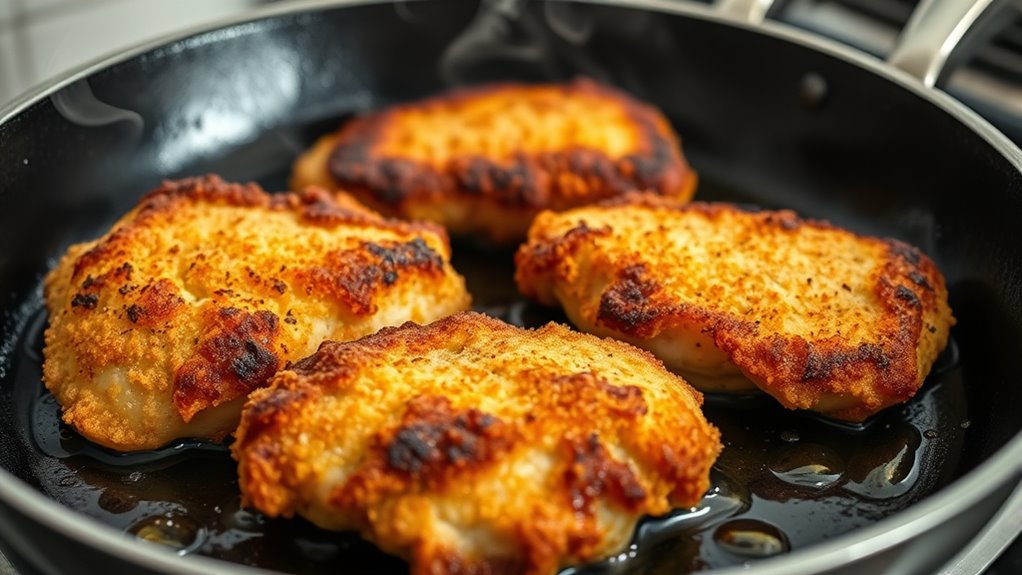
Using the wrong type of fat or oil can substantially hinder your Maillard reaction, resulting in less flavorful and less browned food. Different types of fats have varying smoke points and flavor profiles that influence browning. Poor oil selection can also lead to uneven cooking or burnt flavors. To optimize your results, consider these tips:
- Choose oils with high smoke points, like avocado or refined safflower, to prevent burning during high-heat cooking.
- Use fats with neutral flavors, such as light olive oil or canola, to avoid overpowering the natural taste of your ingredients.
- Avoid saturated fats like butter or coconut oil in high-temperature applications, as they can break down and inhibit proper browning.
- Selecting appropriate fats with suitable properties can also support the overall cooking process and ensure better flavor development.
Proper oil selection enhances the Maillard reaction, ensuring richer, more complex flavors.
Not Adjusting for Humidity and Climate Conditions

Humidity and climate conditions can considerably impact the Maillard reaction, making it essential to adjust your cooking approach accordingly. High humidity levels increase moisture on food surfaces, slowing down browning and often resulting in less flavorful crusts. Conversely, dry climates promote faster moisture evaporation, which can lead to overly rapid browning or burning if not monitored carefully. Climate considerations, such as altitude and temperature, also influence heat transfer and moisture content, affecting the reaction’s progress. To get consistent results, you might need to tweak cooking times, temperatures, or even the seasoning process based on your environment. Being aware of the humidity impact helps you maintain control, ensuring your dishes develop the perfect Maillard flavor without unexpected setbacks. Additionally, understanding how climate conditions influence heat transfer can help you better adapt your cooking techniques for optimal browning.
Ignoring the Importance of Ph Levels
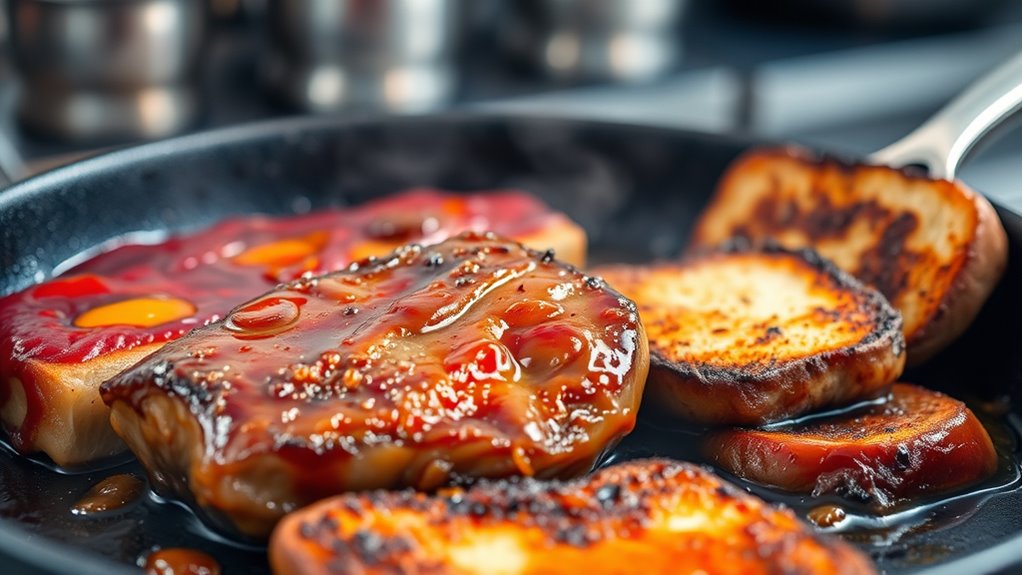
While adjusting for humidity and climate is important, overlooking the pH level of ingredients can also lead to uneven or subpar Maillard reactions. The pH balance and acidity level directly influence browning efficiency and flavor development. To enhance your results, consider these key points:
- Monitor pH levels: Use pH strips or a meter to measure your ingredients, ensuring an ideal range of 5.0 to 6.0 for best Maillard browning.
- Adjust acidity: Add small amounts of baking soda or lemon juice to modify pH, making sure to avoid drastic shifts that could hinder the reaction.
- Choose ingredients wisely: Some foods naturally have higher or lower pH; selecting ingredients with suitable acidity levels helps achieve consistent browning and flavor.
- Understanding food chemistry can help you better predict how pH adjustments will impact the Maillard process and overall flavor outcomes.
Ignoring pH balance can compromise your Maillard reaction and final flavor profile.
Frequently Asked Questions
How Does the Maillard Reaction Affect Food Flavor and Aroma?
The Maillard reaction enhances your food’s flavor and aroma by creating complex compounds that develop during cooking. It boosts flavor enhancement, making dishes taste richer and more savory. At the same time, it drives aroma development, filling your kitchen with enticing smells. Properly controlling temperature and timing ensures these reactions occur ideally, giving your food a delicious, appealing aroma and depth of flavor that elevates your culinary experience.
What Are Common Signs That Maillard Browning Is Occurring Correctly?
Think of the Maillard reaction as a painter’s brushstroke; your dish begins to shimmer with a rich, golden hue. You’ll notice visual cues like deepening browning and a glossy surface, signaling progress. Texture changes also hint at success—foods become firmer or slightly crisp. If these signs appear, you’re on the right track. Trust your senses, and you’ll master the art of perfect browning every time.
Can the Maillard Reaction Happen at Room Temperature?
The Maillard reaction can happen at room temperature, but it occurs very slowly because the reaction rate is much lower without heat. Typically, browning and flavor development happen faster when you increase the temperature. If you want to see the reaction at room temperature, it may take days or even weeks. To speed things up, gently warm your ingredients or cook them at higher temperatures for better results.
How Does Sugar Content Influence Maillard Browning?
Did you know that higher sugar content can increase Maillard browning by up to 30%? When sugar levels are elevated, it promotes sugar crystallization and accelerates caramel development, intensifying browning. You’ll notice richer flavors and deeper color, but be careful—too much sugar can lead to burnt tastes. Adjusting sugar content helps control the Maillard reaction, ensuring perfect browning without overdoing it.
Are There Health Considerations Related to Maillard Reaction Products?
You should be aware that Maillard reaction products can pose health risks if consumed excessively, as they sometimes contain harmful compounds like acrylamide. While they enhance flavor and appearance, these compounds may negatively impact your health over time. The nutritional impact varies, but moderation is key. To minimize risks, avoid over-browning foods and opt for cooking methods that reduce harmful byproducts, ensuring your meals stay both tasty and healthier.
Conclusion
Mastering the Maillard reaction is like tending a delicate garden—you need the right conditions and attention to detail. I once rushed to sear steak without drying it first, and all I got was a steamed mess. Remember, small adjustments like drying ingredients or preheating your pan can turn a bland dish into a flavorful masterpiece. Pay attention to these mistakes, and you’ll reveal the rich, complex flavors that make Maillard browning truly shine.
